Panning is a super important part of the music production process.
It’s the technique of distributing sound across the stereo field, creating a sense of space and depth in your tracks.
As a music producer, understanding panning can help you produce epic soundscapes and position elements within a mix properly.
And, ultimately, transform a flat, one-dimensional recording into a dynamic, immersive experience, which is exactly why we’re breaking it all down today.
Throughout this article, we’ll be covering:
- The fundamental concepts of panning in music ✓
- How pan pot influences stereo imaging ✓
- Differences between stereo balancers & true stereo panning ✓
- Techniques for producing a perfect stereo mix ✓
- Balancing lead vocals and instruments in the center pan ✓
- Depth and width in the stereo field ✓
- The dynamics of panning automation ✓
- Creative uses of hard panning (hard left/hard right) to create interest ✓
- What is panning in music & its secrets ✓
- Practical applications in music production ✓
- Advanced panning techniques for modern producers ✓
- Understanding pan law and its implications ✓
- How to pan instruments successfully ✓
- Enhancing your skills with panning software and plugins ✓
- Much more about what is panning in music ✓
After reading this article, panning will be a regular part of your music-making process and you’ll be producing compelling tracks every time.
You’ll be able to navigate the stereo field with ease, place sounds precisely where they belong, and add a new layer of creativity to your music production process.
Plus, your sounds will always be pristine, professional, and, most importantly, balanced.
So, let’s dive in…
Table of Contents
- What is Panning in Music Production?
- The Role of Pan Pot in Stereo Imaging
- Stereo Balancers vs True Stereo Panning: What’s The Difference?
- Producing the Perfect Stereo Mix
- Expert Panning Applications in Music Production
- What is Pan Law? Breaking it Down
- Software and Plugins: Enhancing Your Panning Skills
- What is Panning in Music? Final Thoughts
What is Panning in Music Production?
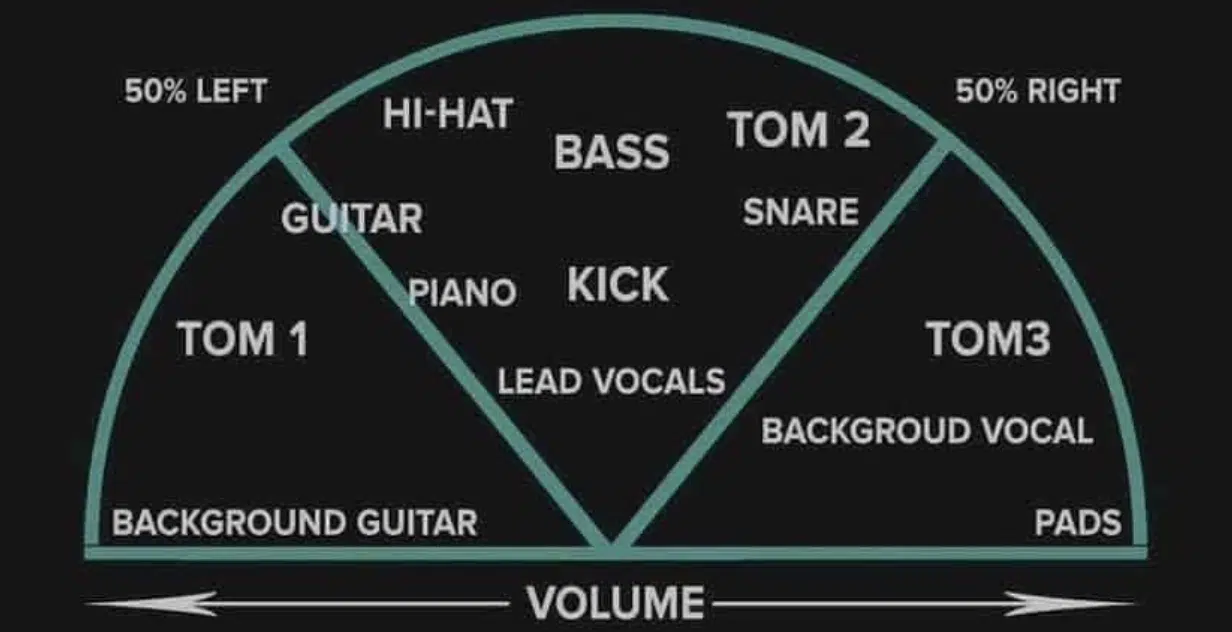
Panning refers to the spatial distribution of sound within a stereo mix.
Audio panning, integral to creating depth and immersion in music, allows you to position sounds in various locations between the left and right speakers.
The key concept here is to create a stereo image that mimics the real-world distribution of sound 一 making the listening experience more natural and engaging.
When discussing panning in music production, we’re talking about utilizing the stereo field to place elements like:
- Lead vocals
- A drum kit
- Synths
- Etc.
A well-panned track can transport the listener into a virtual concert hall, with each instrument occupying its own space.
It contributes to a rich and dynamic audio landscape, which is the ultimate goal.
So, needless to say, if you want to produce professional, captivating music, audio panning is essential.
The Role of Pan Pot in Stereo Imaging
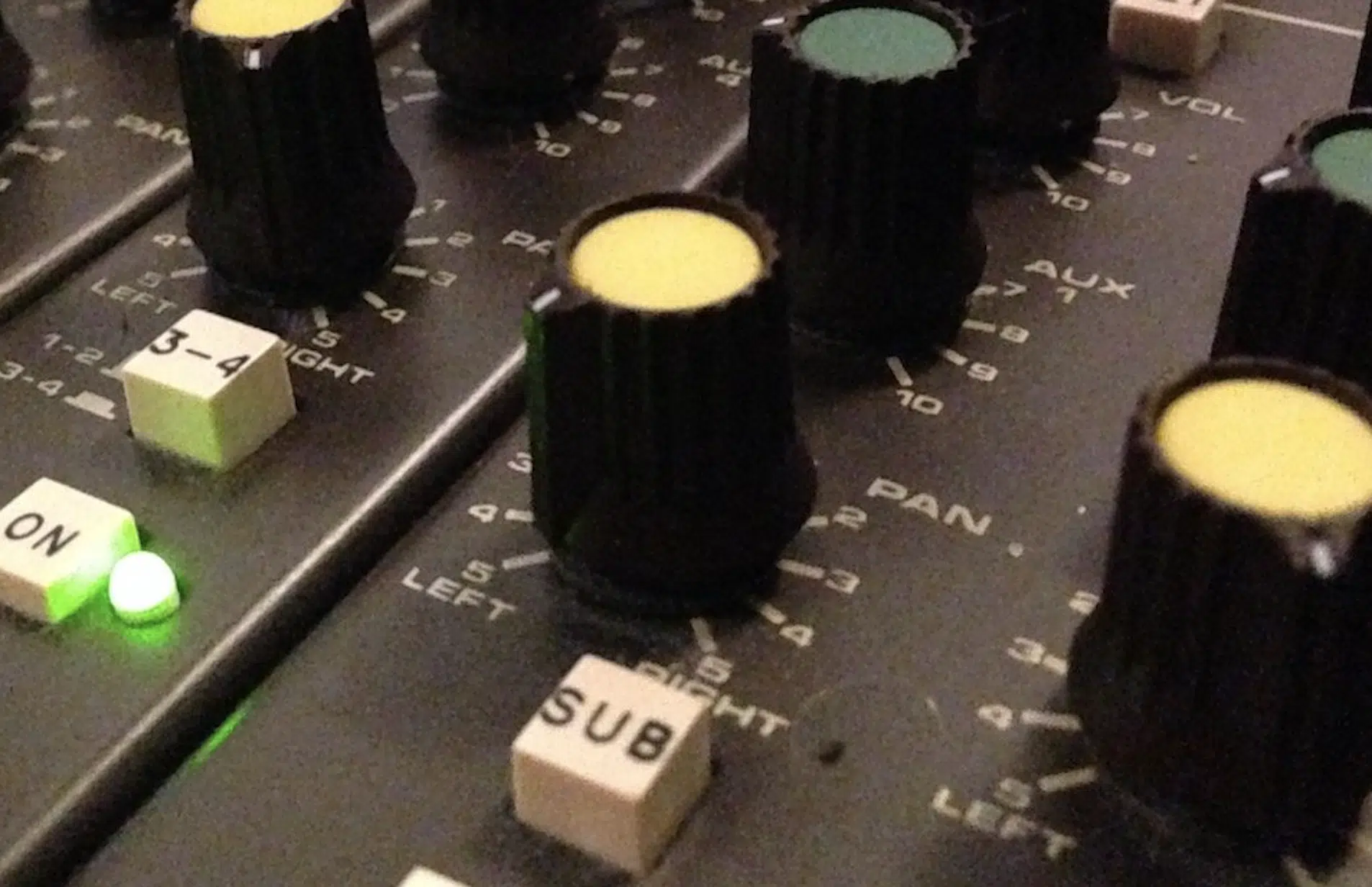
The pan pot, or panoramic potentiometer, is a fundamental tool in audio panning.
It’s the gateway to manipulating the stereo image, allowing producers to distribute sound between the left and right channels.
This control, which can be found on audio mixing boards or in digital audio workstations (DAWs), is crucial for shaping how music is perceived in a stereo environment.
Adjusting the pan pot can shift a sound from the left speaker to the right speaker, and anywhere in between.
This manipulation is pivotal for defining the stereo width and enhancing the spatial feel of the mix.
For example, by panning a guitar solo hard left and a keyboard sequence hard right, you can create a compelling call-and-response effect in the stereo field.
Utilizing the pan pot effectively requires an understanding of how different sounds interact within the stereo mix.
Panning low-frequency elements, for example, like a bass guitar or kick drum, towards the center (center pan) ensures they hold down the mix.
Higher-frequency elements, on the other hand, like hi-hats and cymbals can be panned more freely to create a sense of openness and airiness.
It’s all about understanding this delicate balance and using it to enhance your tracks..
Stereo Balancers vs True Stereo Panning: What’s The Difference?
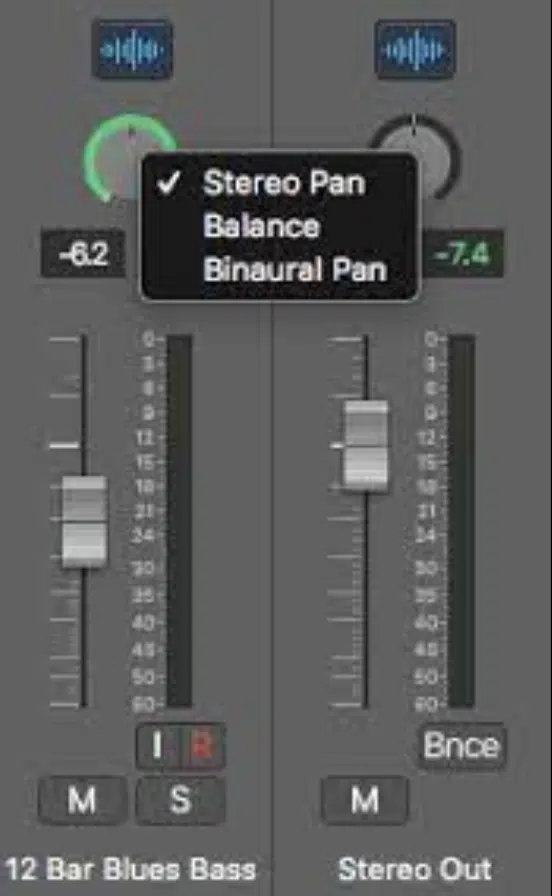
The distinction between stereo balancers and true stereo panning is super important in music production.
Stereo balancers, found in most DAWs, adjust the balance of existing stereo tracks without changing the panning position of the individual elements within those tracks.
They’re used for quick adjustments or corrections in the stereo image.
True stereo panning, on the other hand, involves the precise placement of individual sound sources within the stereo field.
This technique provides a much higher level of control and creativity 一 allowing music producers (like yourself) to create unique and immersive soundscapes.
For example, in electronic music, a synth pad might be dynamically panned across the stereo field to create a swirling, enveloping effect.
Choosing between stereo balancers and true stereo panning depends largely on the needs of the mix and the creative intentions of the music producer.
While stereo balancers are ideal for subtle, broad-stroke adjustments, true stereo panning is indispensable for detailed, creative placement of other sounds.
Producing the Perfect Stereo Mix
Achieving the perfect stereo mix is a blend of technical skill and artistic vision. Your aim as a music producer should be to use panning to create mixes that are not only balanced but also emotionally captivating. So, let’s break down how.
-
Balancing Lead Vocals and Instruments in Center Pan
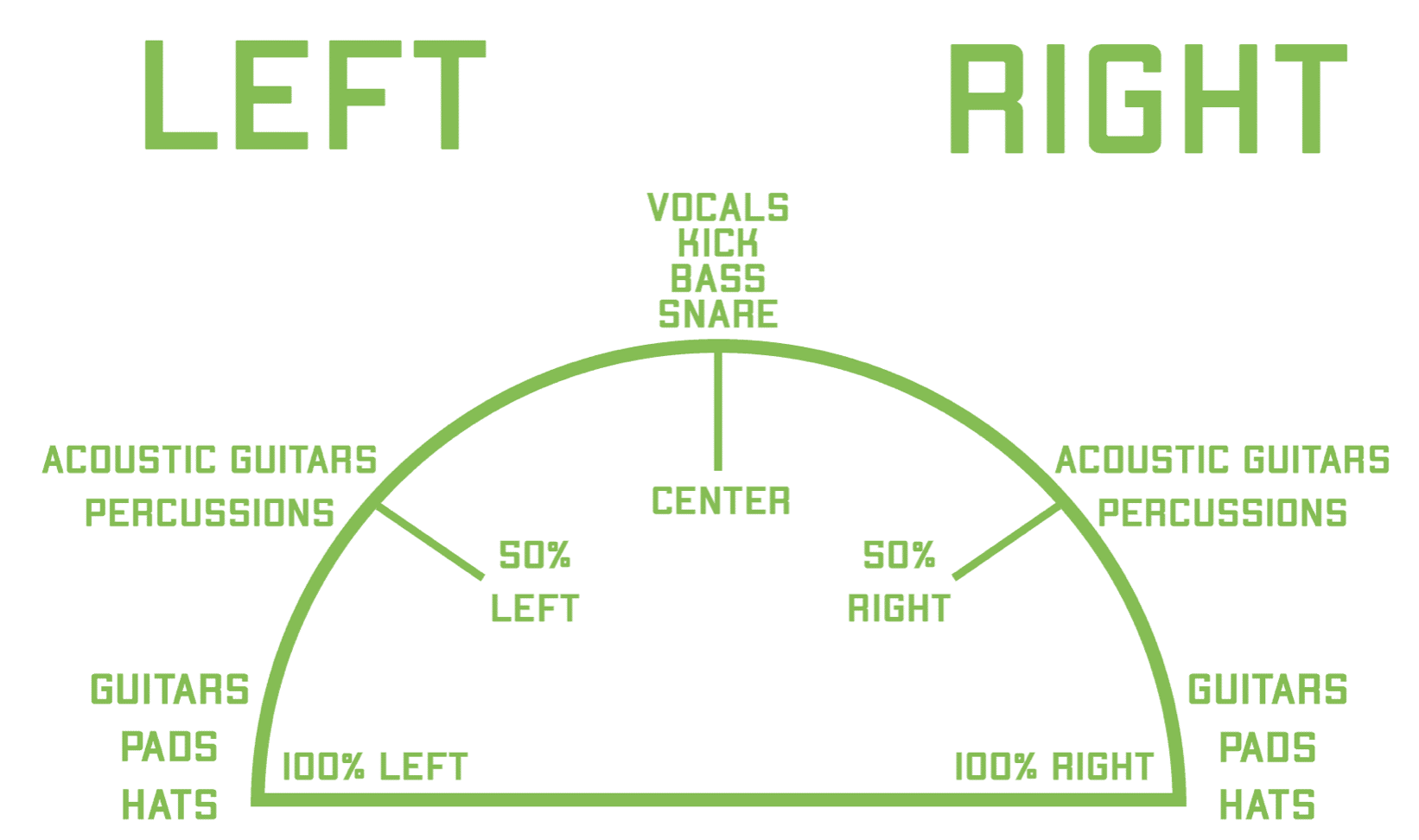
Central to any great mix is the strategic placement of key elements in the center pan, which typically includes lead vocals, bass guitar, and the kick drum.
Panning these elements centrally ensures that they provide a solid foundation for the track 一 maintaining clarity and focus regardless of the listener’s audio setup.
The center pan is also where we often place other important elements like snare drums or certain keyboard parts.
The goal is to:
- Create a balanced and powerful core that anchors the entire mix.
- Ensure that the primary focus remains fluid when you pan certain instruments.
Remember, always ensure your mix is mono-compatible; I cannot say it enough.
This is crucial because some panning techniques might sound great in stereo but lose their impact when summed to mono sounds.
These panning techniques especially include those involving polarity manipulation or delay effects.
This check is essential for ensuring your mix translates well in different environments, including club settings where mono playback systems are common.
-
Utilizing the Stereo Field for Depth and Width
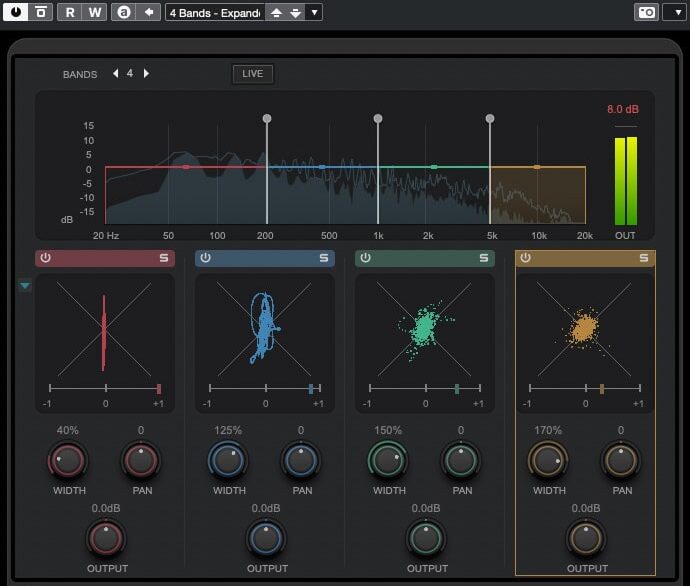
The stereo field is not just about left and right placement and your left ear/right ear 一 it’s a dynamic approach to creating depth and width in your mix.
Consider a scenario where you’re mixing a track with layered synths…
By panning some synth layers slightly to the left and others to the right, you can create wider, more immersive sounds.
This technique is especially effective when each layer has different sonic characteristics, like a bright lead synth panned to the left and a warm pad to the right.
Depth can be added by manipulating the stereo field combined with volume and effects.
For instance, by panning background vocals slightly to the left and right and adding a touch of reverb, they can appear farther back in the mix.
This will provides a sense of three-dimensional same space.
This approach helps in creating a stereo mix where each element has its place, from the up-front lead vocals to the subtleties of ambient textures.
NOTE: Remember, when first attempting to understand the subtleties of mixing (including what is panning in music), you must expertly utilize the pan control to distribute sound signals between the left and right buses.
This will help you effectively shape the stereo pan of the track like a pro.
-
Panning Automation: Bringing Movement to Your Music
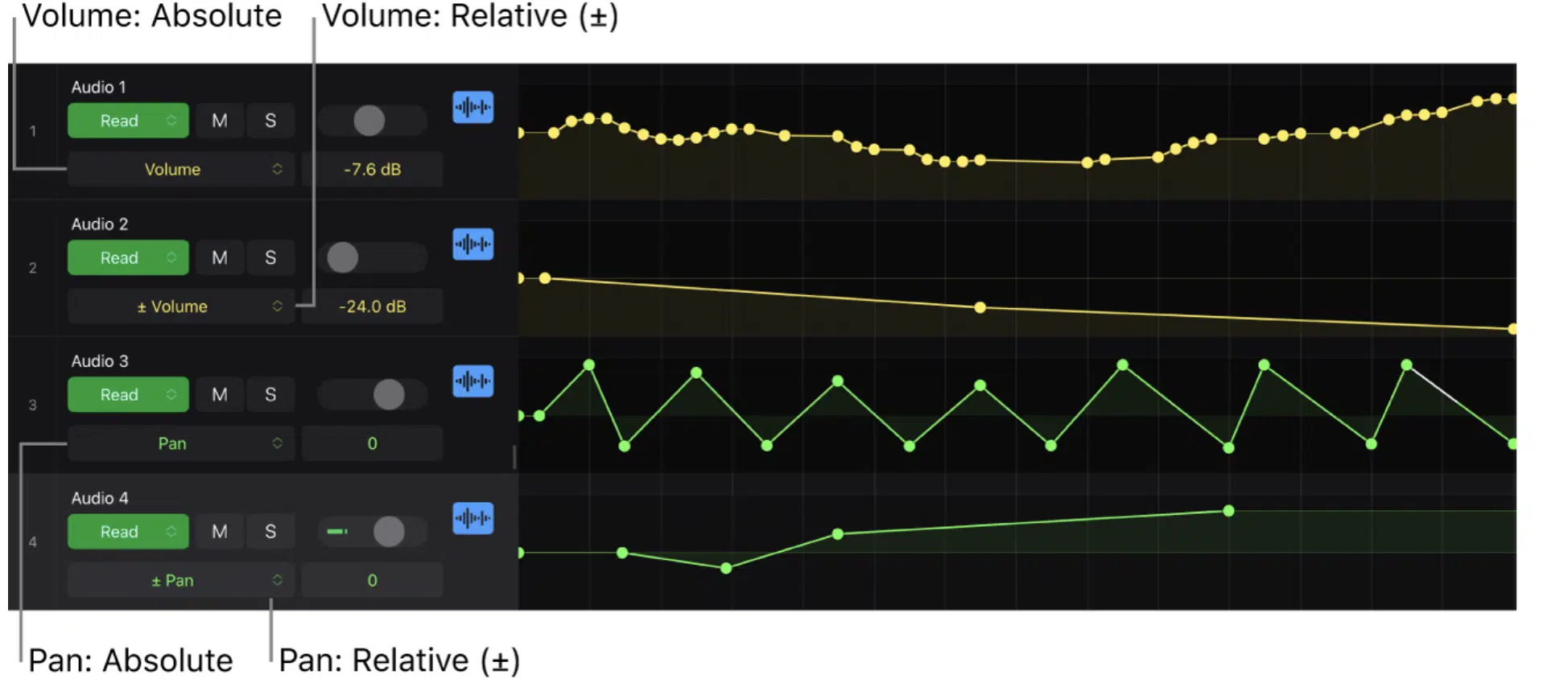
Panning automation is a dynamic technique that breathes life into a mix, essential for any level music producer to create captivating sounds.
Just picture a synth line that moves across the stereo field, starting from one speaker (the left speaker) and gradually moving to the right during a crescendo.
This movement not only captures the listener’s attention but also adds a dramatic element to the track’s progression and ensures your mix sounds official.
In genres like ambient or electronic music, panning automation can create a swirling, almost hypnotic effect.
By automating the panning of certain instruments like a hi-hat or a percussive loop, you can create a rhythmic movement that enhances the groove of the track.
This makes the stereo mix more engaging and lively.
So, if you’re a fan of a dynamic mix and addicting soundscape (which, you are), audio panning in music will help get you there, even if it’s by just one instrument.
-
Exploring Hard Panning for Dramatic Effects
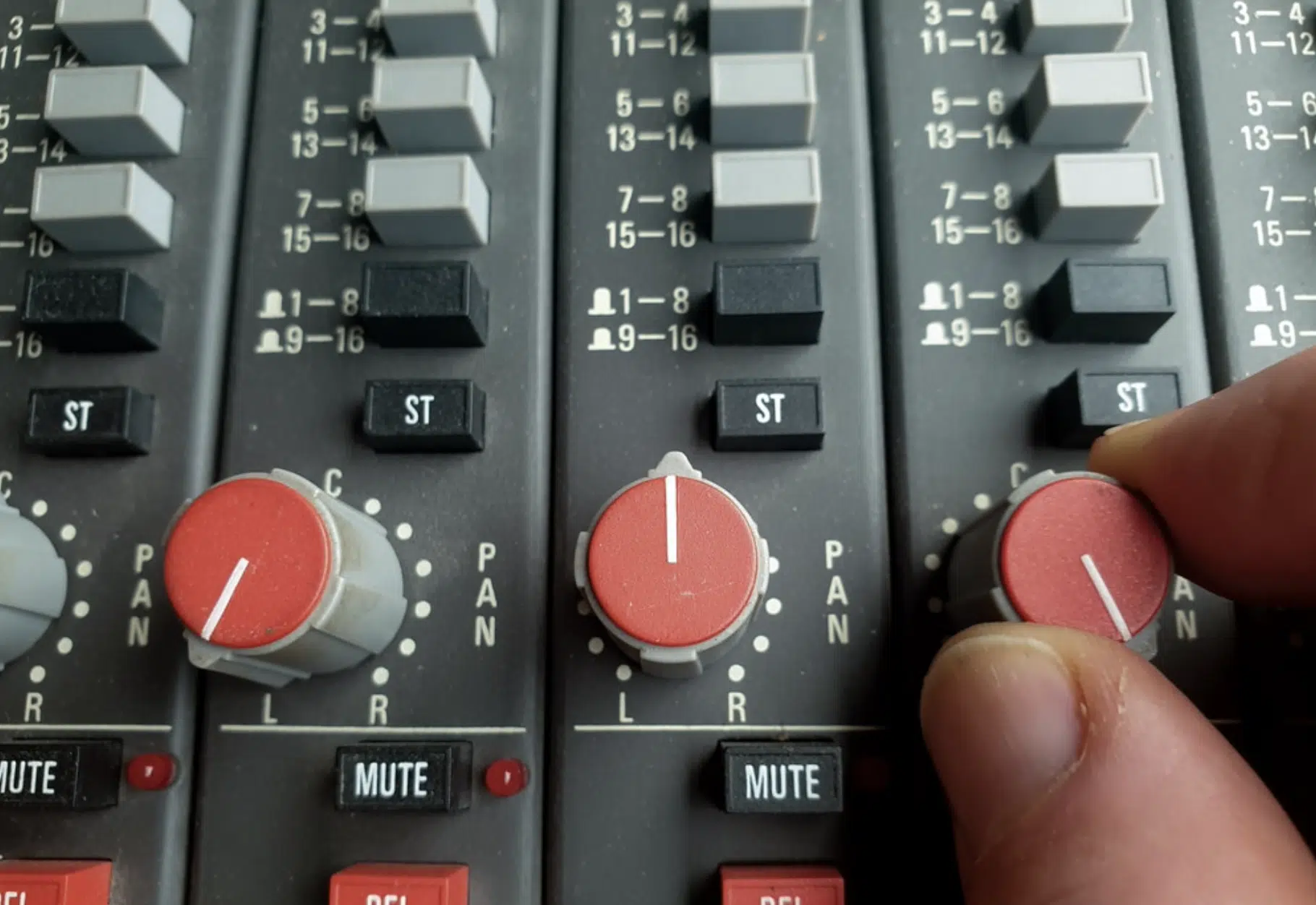
Hard panning (hard left/hard right) is a bold technique where a sound is placed entirely in one channel, either the left channel or the right channel.
For example, when working on a rock track with two guitar parts, you could try hard panning one guitar to the left channel and the other to the right channel.
It will create a wide, enveloping sound that captures the energy of a live performance.
Remember, it’s all about those left and right channels when you’re learning what is panning in music.
While a bit extreme, this audio panning technique is also effective in genres like psychedelic or experimental music.
This is because it’s very common for hard panning to be used to create a disorienting, immersive experience.
For instance, hard panning a reverse guitar effect to one side and a delay-soaked vocal snippet to the other can create a surreal soundscape that plays with the listener’s perception.
Expert Panning Applications in Music Production
Expert application of panning in music production involves a blend of technical know-how and creative experimentation. Let’s break down how panning is applied to create cohesive and standout mixes, generally speaking.
-
Pro Tip: The Art of Panning Instruments (Creating a Cohesive Mix)
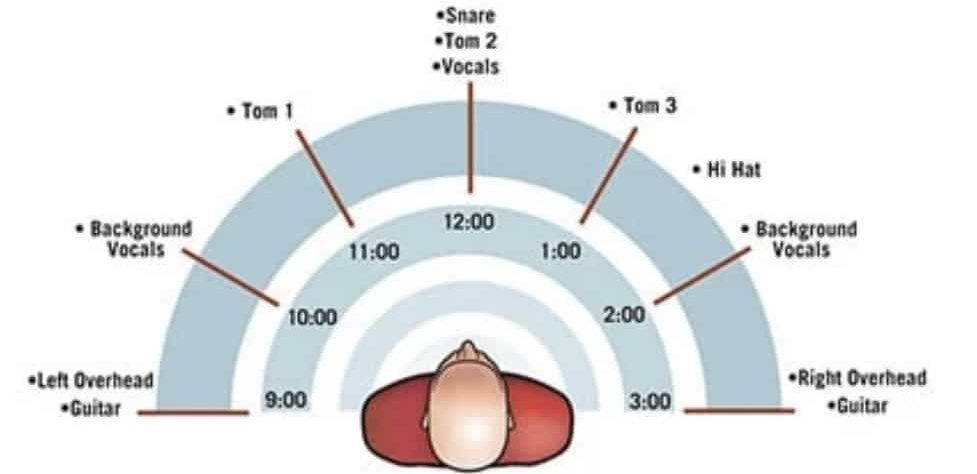
Regardless of the genre you produce, panning instruments is crucial for creating a mix that’s both cohesive and dynamically interesting.
For example, in a trap track, you might pan the hi-hats slightly to one side to create a sense of movement and rhythm, while keeping the kick drum and bass centered for a solid foundation.
Panning elements like snare rolls or percussive accents can add depth and excitement.
It ensures each sound has its own space without overwhelming the central elements like lead vocals.
In pop or R&B productions, panning can be used creatively to enhance the stereo mix.
Consider a track with multiple vocal layers:
- The main vocals 一 Can be kept centrally focused.
- The background vocals or ad-libs 一 Can be panned to the left and right sides to create a fuller, more enveloping sound.
Again, it’s all about finding that desirable balance and creating a cohesive mix.
For other instruments, like keyboards or synths, subtle panning adjustments can ensure they complement rather than compete with the central elements.
For instance, a rhythmic synth pattern might be panned slightly off-center to add stereo width, balancing the mix and creating a more engaging listening experience.
-
Stereo Width: Making Your Mix Music Stand Out
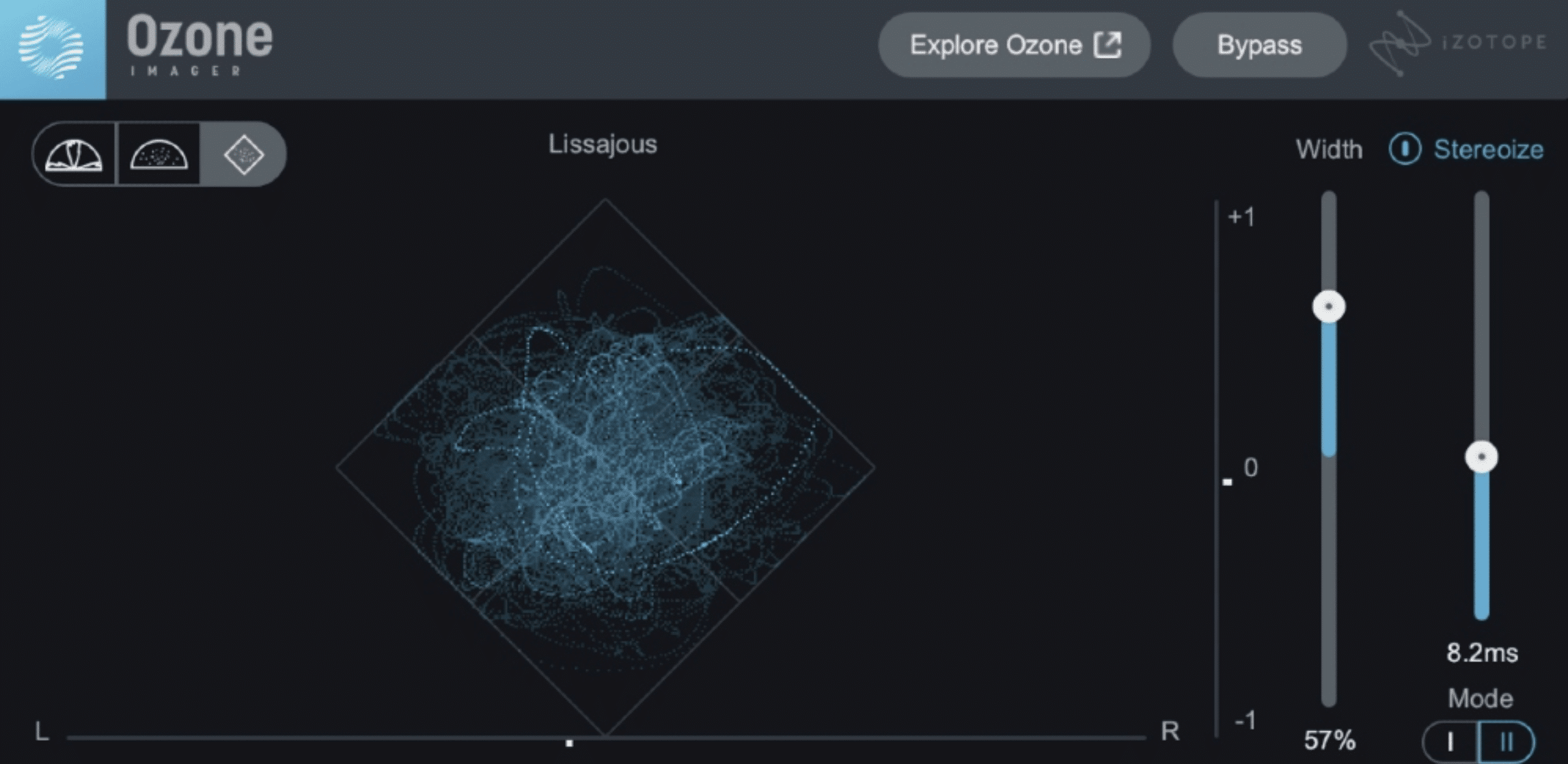
Stereo width is a crucial aspect of modern music production, determining how broad or narrow the mix feels.
For example:
- A track with a narrow stereo image 一 Might sound flat and lifeless.
- A mix with a wide stereo image 一 Feels more alive and immersive.
A mix with well-managed stereo width will have elements such as hi-hats, synths, and background vocals strategically spread across the stereo field.
It creates an expansive and enveloping sound (which is what you’re looking for!).
This panning technique is especially important in digital music production, where stereo width can add a professional vibe to the final mix.
Achieving optimal stereo width involves thoughtful panning decisions.
For instance, panning the hi-hat slightly off-center can add a sense of airiness and space, while keeping the core elements like lead vocals and bass guitar centered ensures stability and focus in the mix.
The key is to balance the spread of elements across the stereo field without causing disorientation or a lopsided listening experience.
-
Pan Positions: Finding the Sweet Spot in Your Mix
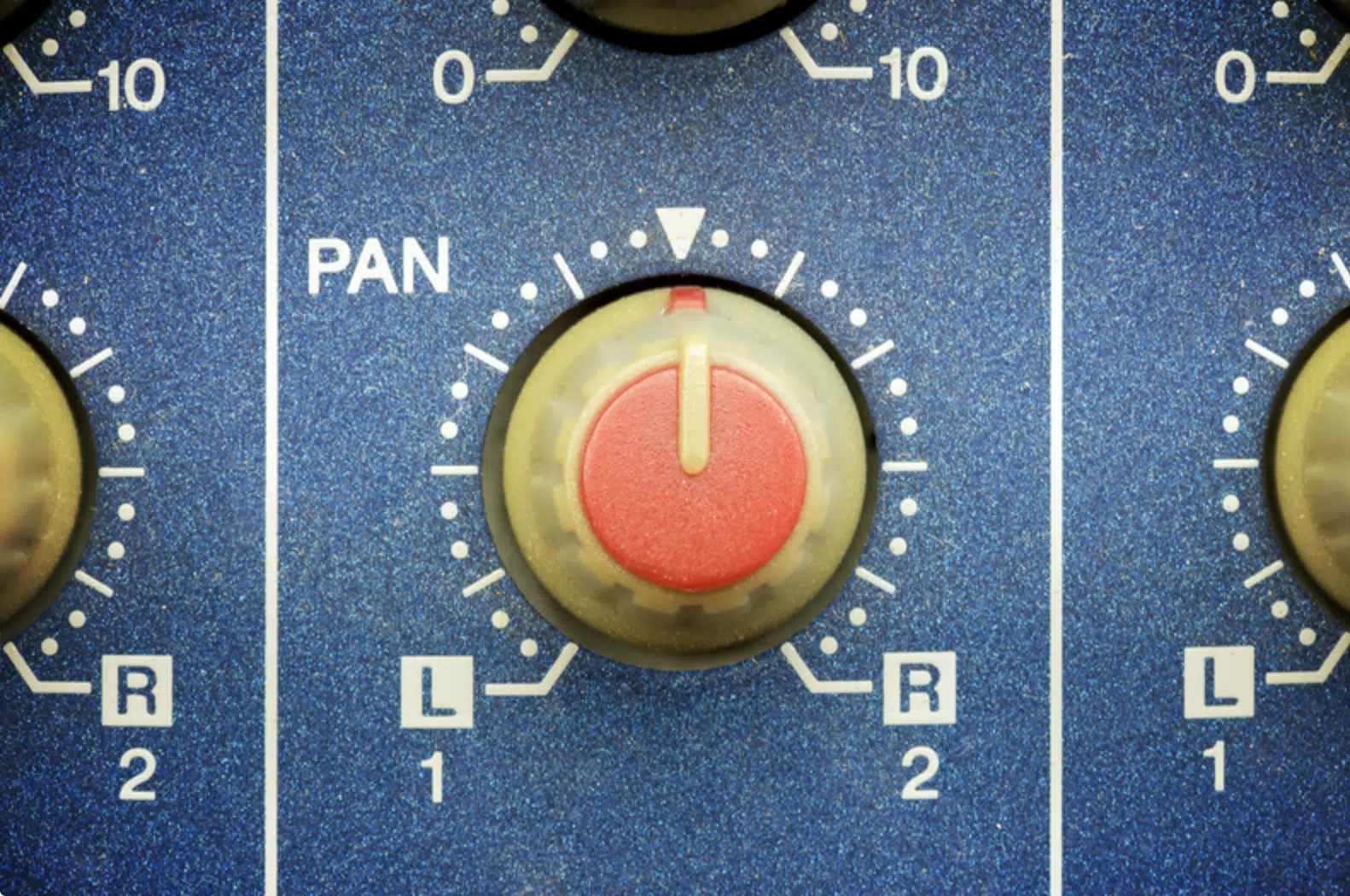
Identifying the perfect pan positions in a mix is both an art and a science.
It involves understanding the interaction between different instruments and how they occupy the stereo field.
For example, placing the lead vocals in the center pan provides a solid foundation, while experimenting with the pan positions of stereo sounds like synth pads or electric guitars can add depth and dimension to the mix.
Panning should always serve the song and the intended listening experience.
If a guitar solo needs to stand out in a particular section, consider panning it away from the center to give it its own space.
Perhaps, complement it with a background element like a keyboard or a hi-hat panned in the opposite direction.
This technique not only highlights the guitar solo but also maintains a balanced and engaging stereo mix.
NOTE: When fine-tuning pan positions in your mix, be mindful that panning reduce volume perception; for example, a sound panned left might sound quieter in the stereo channels.
Therefore, carefully adjust your studio monitors to accurately gauge the volume changes caused by panning decisions.
What is Pan Law? Breaking it Down
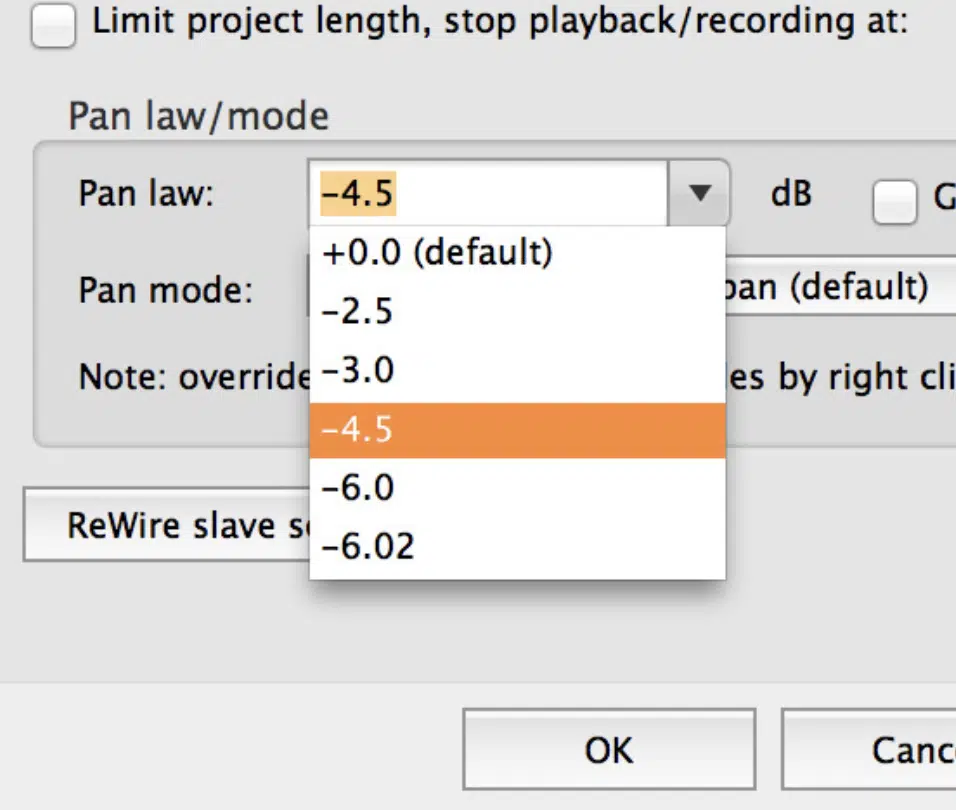
Pan law in music production is a key element in how audio is perceived in a mix.
The concept revolves around the change in perceived loudness of a sound as it is panned between the left and right speakers.
For example, if you pan a vocal track from the center to hard left in a pop song, the vocal might seem quieter, even though its signal level hasn’t changed.
This perception is due to the way our ears and audio systems interact, especially when the sound moves from a mono (center) position to a stereo one (side).
Understanding and adjusting pan law is crucial in DAW settings to maintain balance in your mixes.
The standard settings usually range from -3dB to -6dB of center attenuation.
Choosing the right setting depends on your mix’s end-use:
- For stereo listening, -3dB might be ideal 一 Ensuring the sound remains constant across the stereo field.
- For a mix likely to be summed to mono (like in radio broadcasts/club settings), -6dB might be more appropriate 一 Ensuring the levels/sounds remain consistent when collapsed to a mono signal.
This sliding adjustment is pivotal in professional music production, ensuring your next mix translates well across various listening environments and formats.
Whether it’s your right speaker or left speaker, both the left and right sides will be on point with pan law in mind.
Software and Plugins: Enhancing Your Panning Skills

Modern music production and audio engineering offers a range of software and plugins to enhance panning techniques.
Plugins like Soundtoys’ PanMan and Cableguys’ Pancake 2, which you can hear examples of everywhere, offer creative panning options that go beyond standard DAW pan pots.
PanMan offers rhythmic panning capabilities.
Meaning, it offers automated, tempo-synced panning effects that can add a dynamic feel to rhythmic elements like hi-hats or synth lines.
Meanwhile, Pancake 2 provides a flexible, user-definable panning modulation curve 一 ideal for creating more complex, evolving stereo track movements.
Another valuable tool for enhancing panning skills is MeldaProduction’s MAutoPan, which offers advanced panning control and modulation options.
This plugin can be particularly useful for adding subtle motion to static elements or for more dramatic, creative panning effects in electronic music.
For instance, automating the panning of a stereo synth pad with MAutoPan can create a sweeping effect.
This can enhance your track’s spatial feel and add a layer of depth to the stereo mix.
It’s all about making sure your next mix sounds professional and captivating.
What is Panning in Music? Final Thoughts
Panning, as you now know, is an essential technique in the music production process.
It’s the perfect way to create depth and dimension in your mixes, allowing every element to shine in its own space.
With this knowledge, you can now approach your projects with a refined ear, producing soundscapes that captivate and engage listeners like a professional.
By understanding how to effectively pan instruments across the stereo field, you unlock new dimensions in your music.
Therefore, making your tracks not only more pleasant to listen to but also more professionally polished.
This skill is key for achieving a balanced and immersive listening experience.
To further enhance your journey into professional music production, you’ve got to check out these legendary Free Project Files.
This invaluable resource includes 3 professional-quality project files, giving you an insider look at how industry professionals pan their music and deal with complex arrangements and mixing challenges.
Seeing firsthand how chart-topping tracks are constructed will significantly improve your own music and panning process.
This hands-on experience is super beneficial for understanding the flow of professional audio production, from subtle panning moves to strategic stereo field placement.
So, with your new knowledge and the Free Project Files, you’ll be able to create professional, balanced music like a champ.
Until next time…







Leave a Reply
You must belogged in to post a comment.